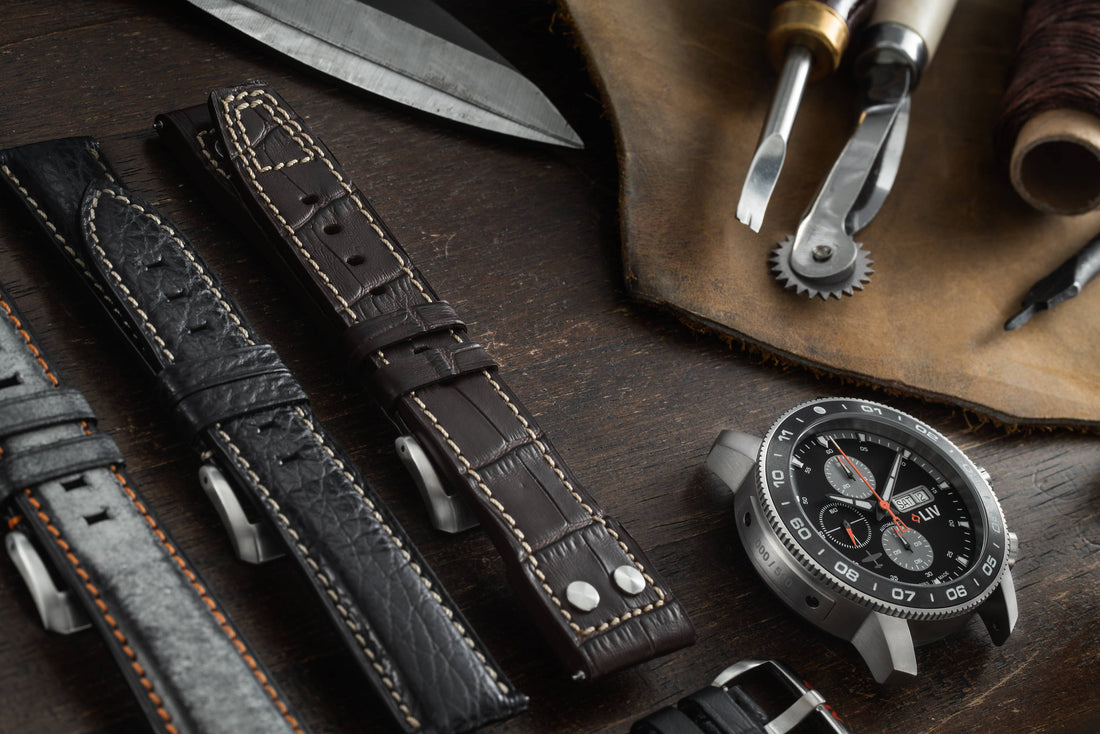STRAP IN FOR A QUICK PRIMER
What’s a watch without a strap? A small, oddly shaped clock, that’s what.
Watch straps are undoubtedly fashion accessories that can change the whole look and feel of the watch it’s attached to, but they’re also the components that turn a watch into a wristwatch.
Oftentimes when people are in the process of finding the right strap for their watch, their mind immediately gravitates towards one word that is synonymous with quality: leather.
LEATHER 101
If you’re attracted to the idea of purchasing a leather watch strap, you should know what you’re getting yourself into. Today we’ll be learning all about leather: where it comes from, its different grades and its different designs in watch straps.
Strap in and buckle up, because you’re about to learn a whole load of information.
SOURCES OF LEATHER
To make sure that the leather watch strap you buy is ethical, you need to know where leather comes from. While cows are the biggest producer of leather, the industry uses leather from other animals too. Some of these other animals include:
- Sheep
- Pigs
- Goats
- Buffalos
- Snakes
- Alligators
- Ostriches
- Stingrays
But WHY is it unethical to source leather from one animal, but not another? Consider the other ‘uses’ of the animal. Leather that is a by-product of an animal is considered ethical and promotive of nose-to-tail sustainability while slaughtering an animal for the sole purpose of making leather is unethical.
For example, leather from a cow is considered ethical as it is an ecological byproduct of slaughtering for meat, whereas leather from a snake is not.
LEATHER 101

Think buying a watch strap with the words “Genuine Leather” on it means you’re buying the best of the best? Think again. In reality, you’re scraping the bottom of the barrel when you purchase a genuine leather strap.
Just like there are different sources of leather, there are different grades of leather too. Here’s a breakdown of the five different leather grades available, in order of highest quality to lowest quality, and what its grading means.
FULL-GRAIN LEATHER
Full-grain leather comes from the most durable part of the animal and has the most grain of the animal’s hide intact.
All of the natural characteristics of the leather are visible in full-grain leather—imperfections and all. A watch strap made with full-grain weather will last long and withstand wear better than any other grade of leather.
TOP-GRAIN LEATHER
Top-grain leather is the second-highest grade of leather. As the name implies, like full-grain leather, this grade of leather also comes from the top cut of the animal hide.
But unlike full-grain leather, top-grain leather undergoes processing to rid it of blemishes, scarring, and other imperfections. Top-grain leather watch straps will last a while but, because of the processing process, won’t age as well as full-grain leather watch straps will.
SPLIT-GRAIN LEATHER
You might know split-grain leather by its other name: suede. Split-grain comes from the top part of the hide but four to five levels deeper, which means it’s not as tough as higher grades of leather.
If you prefer comfort over quality or just plain love suede, split-grain leather watch straps will serve you well. Watch straps that are made from split-grain leather are soft, smooth and flexible.
GENUINE LEATHER
Genuine leather sounds enticing, but that’s just because it’s a clever choice of name used to describe leather of a low quality.
Where does genuine leather come from? Simple! Genuine leather comes from the leftovers of leather used to make higher-end products. Genuine leather watch straps won’t last as long as watch straps that are made with the higher grades of leather as listed above.
BONDED LEATHER
Bonded leather is the worst of the worst in terms of quality. Seriously, if you own anything that’s made from bonded leather you should throw it in the bin. Funny enough, that’s where its materials would’ve ended up if they didn’t find its way into your bonded leather product.
Want to know what’s in bonded leather? We’ll tell you, but you aren’t going to like it. Plastic, vinyl, glue that have been bonded with a handful of leather scraps and a dusting of leather dust make up bonded leather products.
Genuine leather sounds enticing, but that’s just because it’s a clever choice of name used to describe leather of a low quality.
LEATHER GRAINS AND DESIGNS
Watch straps feature all kinds of different grains and designs, so picking the right one for your watch can be difficult. Broadly speaking, a leather watch strap will almost always feature a design of solid leather with visible stitching.
There are countless leather watch strap designs available on the market, so to make our life (and yours!) easier, we’ll be discussing the designs of some of our bestselling watch straps.
SUEDE LEATHER WATCH STRAP

Our suede leather watch strap consists of smooth, solid color design with bold stitching in a complementary color. Your color options are tan suede with white stitching as well as black suede with orange, black or blue stitching.
WAXED LEATHER WATCH STRAP

Designs with a waxed finish look vintage and have a unique streaked lightening effect when folded Our Italian waxed leather strap comes in two colors: black or blue. Fun fact for you: The waxed leather design was inspired by Timberland boots.
ALLIGATOR LEATHER WATCH STRAP

An alligator leather watch strap will almost always feature a simple design that shows off the leather’s natural characteristics. We have alligator watch straps available in black, orange and blue all finished with a shiny topcoat.
NOT ALL LEATHER STRAPS ARE CREATED EQUALLY
As you can tell from our breakdown of leather grades, not all leather straps are created equally.
Factors that influence the quality of the leather used to make watch straps include:
- The animal’s diet and level of nutrition
- How old the animal was and its gender
- The living conditions of the animal
- The quality of the slaughtering process it underwent
- The care taken during flaying
- The chemicals used in the tanning process
- The dyes and stains used to finish the leather
CARING FOR YOUR LEATHER STRAP
Regular cleaning is a leather watch strap requirement, so make sure that you’re committed enough to do so. Thankfully, the actual cleaning process is as easy as can be and consists of only three steps:
STEP 1: WIPE
Because a watch strap rests against human skin, it can trap all sorts of things under it and attract just as many things onto it. It’s important to properly wipe down your watch strap before washing it to prevent dirt from scratching the leather surface while you’re scrubbing it. A soft, dry cloth will do the job perfectly.
STEP 2: SCRUB
Grab a soft cloth and a bucket of warm, soapy water & you’re good to go. Gently scrub both sides of the watch strap and pay particular attention to its edges. Once you’ve given the strap a good scrub, rinse out your cloth and wipe off any soap residue before patting it dry with a dry cloth.
STEP 3: CONDITION
Once your watch strap is clean and dry, treat it to a little conditioner treatment. The conditioner does to leather what moisturizer does to the skin—keeps it hydrated and soft. Keeping a watch strap hydrated makes it last longer while keeping it soft makes wearing it a more pleasurable experience.
FINAL THOUGHTS
And there you have it! The lowdown on all things relating to leather watch straps. Now the only question left is: will you be adding a leather watch strap to your collection or be sticking to silicone, bracelet, nato or canvas watch straps?
Let us know your watch strap preference in the comments section below!
About the Author

Esti Chazanow, Co-Founder at LIV Watches
Esti's passion for men's watches led her to co-found LIV Watches—a microbrand dedicated to connecting watch collectors with high quality, limited edition, Swiss Made timepieces at prices they can afford—and the rest is horological history.


